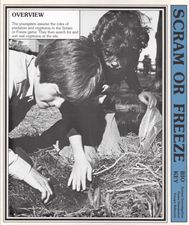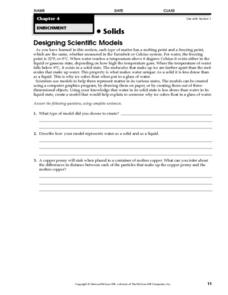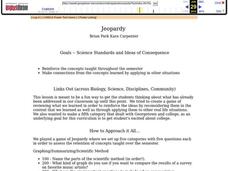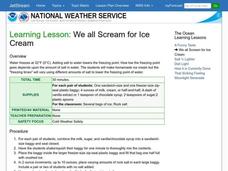K12 Reader
Measuring Temperature
Fahrenheit? Celsius? What's the difference, and where did these two temperature scales originate? Your pupils will learn all about these topics by reading the passage included here. After reading, individuals respond to five questions...
Curated OER
Noodle Stop Soccer
Students play a variation of Freeze Tag. Two students are selected to be noodle stoppers. Other students receive a soccer ball and place it along the goal line. They dribble their balls to the opposite goal and attempt to score. Noodle...
Curated OER
Scram or Freeze
Students participate in a role-play game. In this cryptozoa activity, students simulate the roles of predator and cryptozoa in a game called Scram or Freeze.
Curated OER
Heat - A Form of Energy
Middle school or high school physical science pupils will warm up to the topic of heat when viewing this set of slides. It covers heat transfer, measurement tools, phase changes, and more. Have demonstrations and examples of the tools...
Curated OER
To Freeze or Not to Freeze
Young scholars examine the non-verbal elements of a theatrical performance. They read an article, answer discussion questions, conduct Internet research, and stage frozen tableaux based on lines from Shakespeare's works.
Curated OER
Breezy, Chilly, or Freezing?
Students assess the factors which influence the sensation of being "cold" in a particular situation. They study the complexities in measuring temperature by reading and discussing the article "Beyond Brrr: The Elusive Science of...
Curated OER
Practice Sheet: Colligative Properties
For this colligative properties worksheet, students solve eight problems. They calculate molarity, molality and grams of substances in addition to using colligative properties to calculate solutions.
Curated OER
Designing Scientific Models
In this scientific models worksheet, students will use a model to represent matter in its various states. Students can use a computer graphics program, drawing on paper, or three-dimensional creation. Then students will complete 3 short...
Curated OER
WS 5.2 Kinetic Theory-Temperature and Volume
In this kinetic theory activity, students are given fifteen questions about gases and their kinetic energy, how temperature effects kinetic energy, and the results of changing conditions of gases on the kinetic energy. They convert from...
Curated OER
Gas Pressure, Volume, and Temperature
Physical science learners conduct a simple experiment using the heat of their hands to affect the fluid pressure. They place a balloon atop a freezing cold bottle and observe what occurs as it warms up. Both activities demonstrate how...
National Geographic
Expedition Clothing Then and Now
Introduce your class to the Everest expedition to reenact a 1924 climb by George Mallory and Andrew Irvine. Discuss and show pictures of the types of clothing worn at that time and compare it to today's state-of-the-art climbing gear....
Curated OER
Theater Arts/Creative Movement Lesson Plan
Here is a series of five exercises intended to bring movement, dance, and theater into the classroom. Intended for special ed classes, but appropriate for any grade, learners will pantomime, play pretend, dance, move, and create...
Curated OER
Jeopardy
High schoolers played a game of Jeopardy where there was five categories with five questions each in order to assess the retention of concepts taught over the semester. The categories included: Graphing/Summarizing/ Scientific Method,...
Curated OER
Heating and Cooling Curves
Students experiment with a pure substance and a phase change. In this heating and cooling curves lesson plan, students study the effects of heating and cooling a pure substance to observe a phase change. They determine both the melting...
Polar Trec
South Pole Ice Cream!
How can you turn an ice cream activity into a scientific investigation? It's easy if you know ionic compounds, heat transfer, and the exothermic and endothermic process. Learners will explore the science behind freezing, insulation, and...
Polar Trec
Sea Ice Impact
The arctic seas contain currents that are both warm (with high salinity) and cold (relatively fresh water) that circulate throughout the year. Through discussion, a lab, and a web quest, participants explore the impacts of melting and...
Curated OER
Catch the Beat
Use this rhythm and pattern activity during transition times or on it own. Start by introducing a rhythm with 2, 3, or 4 beats; use your feet, hands, or entire body to demonstrate. Once learners have figured out the pattern, they join...
Sea World
Arctic Animals
Discover the coldest animals in the world with a lesson about the Arctic habitat. Kids use a glossary and information sheet about animals found in the Arctic Circle to complete several activities, including tracking the lemming...
Virginia Department of Education
Thermochemistry: Heat and Chemical Changes
What makes particles attract? Here, learners engage in multiple activities that fully describe colligative properties and allow the ability to critically assess the importance of these properties in daily life. Young chemists conduct...
NOAA
Please Pass the Salt
Salinity is the focus of two experimenters that work to answer the question, How does salt change the physical properties of water? Super scientists compare the freezing rate of salt and fresh water, combine the two waters to observe how...
Curated OER
We All Scream for Ice Cream
Students make ice cream while experimenting with the freezing point of water. They experiment with different amounts of salt.
Curated OER
Glaciers and Ice Wedging
Fourth graders observe buckling sidewalks and potholes before attempting to determine how these things are caused. They freeze water filled plastic cups that have been covered. As the water freezes, the students observe what happens to...
Curated OER
Understanding the Effects of Salt on Ice
Students explore the concept of freezing point in an experiment that shows why salt is effective at clearing ice from roadways in the winter. In small groups, they compare the process of making homemade ice cream in plastic bags with and...
Curated OER
Make Your Own Thermometer
Students recognize the concept of temperature, including degrees, and the melting and freezing process. In this 1st - 2nd grade lesson plan, students identify the temperature of various objects, as well as create their own paper...
Other popular searches
- Freezing Point
- Freezing Point Depression
- Freezing and Melting
- Salt Water Freezing Point
- Freezing and Boiling Point
- Freezing Water
- Freezing Melting Point
- Freezing Salt Water
- Boiling Freezing Point
- Food Preservation Freezing
- Freezing Point of Water
- Freezing Point Water

























